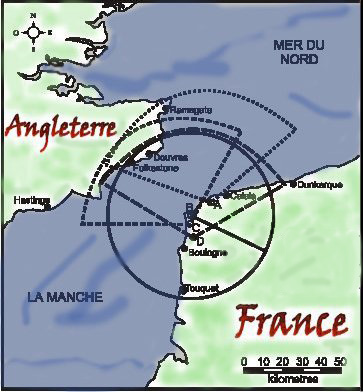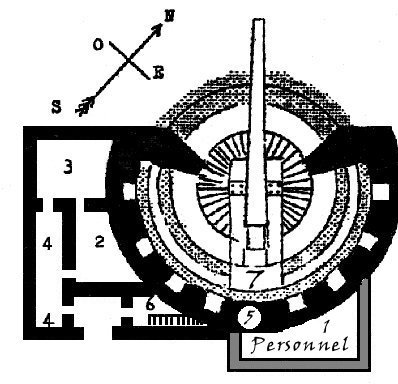June 1940, Hitler gains the war on the face of the West. He will ask an engineer of the name of Todt Fritz which had worked before with the construction of motorways (1933-1938) then of the line Siegfried (1938-1940), the development of a military complex of defense of the Western face in order to be able to move the face in the East:
The Atlantic Wall.
While requisitioning the foreign companies, Fritz Todt was
going to create a wall extending from the North of Norway until the
South of France. In 1942, he died in the plane with the apogee of the
power Nazi…Accident or murder?

During the second world war (1939-1945), the Germans undertook the construction of formidable Batterie Siegfried (renamed Todt in his honor after Todt's death) comprising four guns of 380 mm intended to draw on the English ships and even on England. It formed also part of another unit put in building site including:
- the Battery Grossdeutschland (Lindemann), in Sangatte (3 X 40,6cm) (which
unfortunately disappeared during construction of the Channel tunnel) (
B )
- the Battery Friedrich August, with the Treasury (3 X 30,5cm) (
D )
- the Battery Prinz Heinrich, in Sangatte (2 X 28cm) ( C )
- the Oldenburg Battery, in Calais (2 X 24cm) ( A )

Shooting circle of the various Batteries
Of the four principal blockhouses, that located more at the south east still in perfect state (built by ? Yohann Felden & J Düsseldz ?). Each blockhouse has the shape of a crescent of the moon of which the concave part is turned towards the sea. The roof has 3m.50 thickness. One still sees, by the western opening, the truncated cone out of cement 8 meters in diameter at his base, on which the mounting was planted which supported the gun. The mounting rolled on a horizontal circular rail and another vertical rail.
For more information in the field of the Bunkers belonging to the Battery Todt,
want click here or on the image.
The fourth blockhouse is used today as museum where are preserved many samples of projectiles Alliés and German as well as uniforms and equipment of bunkers (crockery, cupboards, system of ventilation…).
In addition to the four principal blockhouses, innumerable guérites, shelters, kitchens and refectories constellate the ground (soon in photograph). The Todt battery accepted in particular the visits of Hitler, Rudolph Hess, Rommel, etc…
September 29, 1944, the 9th brigade of the 3rd division of the 1st Canadian
army, after massive bombardments and artillery shootings of support, went
up to the attack of the casemates, supported by tanks with plagues and
tanks "Detonator" with anti-blockaus weapons. After a honourable
resistance (with all kinds of weapons and the 360mm), the garrison went,
leaving the intact guns. Highland Light Infantry and North Nova Scotia
Highlanders had made a success of the exploit to put a term at this threat
which weighed since years on England. The Canadian losses rose to 8 dead
and 34 wounded for 1600 captive Germans. After the departure of the Germans,
the French National Navy dismounted the guns and transported them in station
of Aubengue on a platform left by the Germans and who comprised twelve
axles and 48 wheels. The four guns were used as currency of exchange for
the recovery of the guns of the battleship "Brittany", that
the Germans had taken along to Holland. As for the steel shielding which
protected the guns and serving them, as well as the instruments of pointing,
they were sold by the Navy with recuperators.
Galerie Photos (comprenant des photos d'époques).
Voir les différentes salles en 3D.
(Of course, for all the photographs, the rights are reserved)
D. Laurent
Information concerning the museum:
Audinghen ( cap Gris-Nez )
62179
Tél: 03.21.32.97.33
Fax: 03.21.32.00.67
